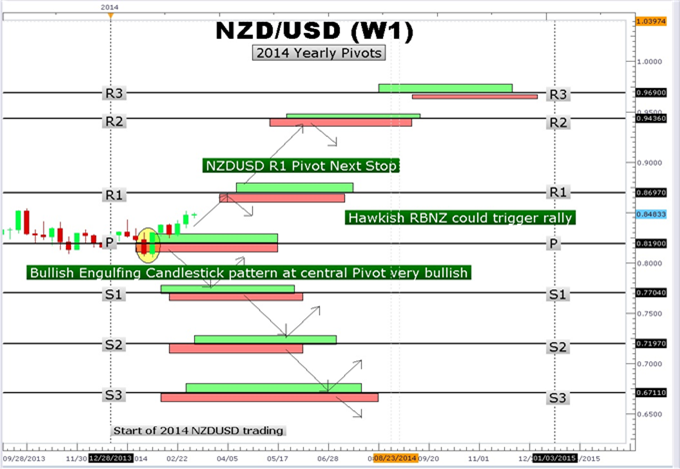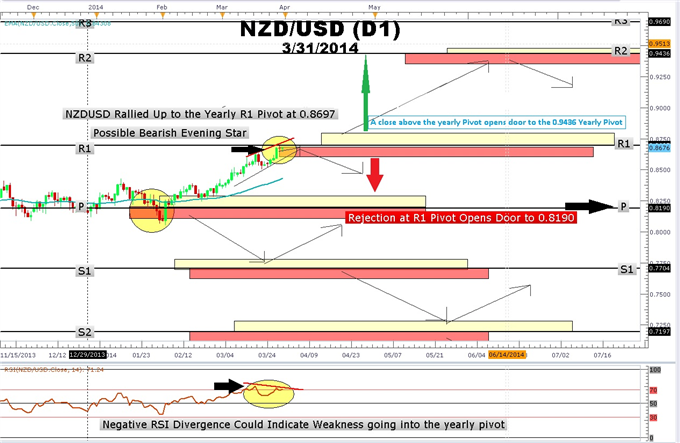Talking Points:
- The Reserve Bank of New Zealand raised rates 25 basis points at their last meeting
- NZDUSD is at 2014 yearly pivot resistance after rebounding strongly from the central yearly pivot
- Forex yearly pivot points can act as formidable areas of resistance turning back price advances.
In the previous NZDUSD yearly pivot article,
we observed how Kiwi price action would behave in relation to the 2014
yearly pivots. We observed how price can rebound sharply from contact
with these long-term price levels. Since yearly pivots are based on the
previous year’s high, low and closing price, these levels are a lot
tougher for price to penetrate the first time because of the time frame
used. The longer the time frame, the more reliable support and
resistance becomes. The article also pointed out that NZDUSD would more
than likely hit the 0.8697 levels in the weeks ahead because price was
rejected.
On March 28th,
NZDUSD hit a high of 0.8695, just 2 pips away from the yearly pivot of
0.8697 before backing down to the 0.8668 area. Renewed Chinese demand
for New Zealand products, plus a quarter-point rate hike to 2.75% sent
the pair flying from the 0.8483 level to 0.8695.
Learn Forex: NZDUSD Weekly Chart coiling before rally

Created with Marketscope 2.0
Pop or Drop?
While picking tops can be losing proposition, NZDUSD
longs may want to consider tightening stops, or reducing position size
as price stalls at the yearly R1 pivot to protect profits. As seen in
the chart above, we see price bouncing strongly from the central pivot
and then continued higher after the RBNZ rate hike.
Other longs may seek to book gains as well ahead of
the US NFP employment number. The beginning of a new month and a new
quarter could make holders slightly wary. I’d like to invite you to make
a trade based on NZDUSD yearly pivots using a free FXCM demo account. You may want to buy a breakout above the yearly R1 pivot or enter short given a reversal at the 0.8697 R1 yearly pivot.
Learn Forex: NZDUSD contact with yearly R1 pivot

Created with Marketscope 2.0
The daily chart above shows NZDUSD pushing against
the yearly pivot. If the trend continues and NZDUSD can close on a
sustained basis above 0.8700, then the door to the R2 yearly pivot at
0.9436 is wide open. A couple of things
NZDUSD bulls need to also consider as possible early warning signs that a
reversal may be near at the yearly R1 pivot.
The first is negative RSI divergence. When price
makes a new high and RSI makes a lower high, then that is negative RSI
divergence. It indicates bullish pressure is subsiding. Divergence is
not a reason to exit a trade alone. Forex traders would also look for a
break of a trend line or a reversal candlestick pattern.
This brings us to our second warning sign; a bearish evening star Japanese candlestick pattern.
This is a three candlestick pattern made up of a wide ranging bullish
candles followed by a spinning top or doji and then by a bearish candle.
This candlestick pattern is not complete as we have two of the three
components.
By the end of the day today, we will have confirmation that either it is or it isn’t a bearish evening star candlestick pattern.If
the yearly R1 area pivot holds as significant area of resistance, we
could see a correction back to 0.8500 which is roughly the midpoint the
central pivot to R1 range.
No comments:
Post a Comment